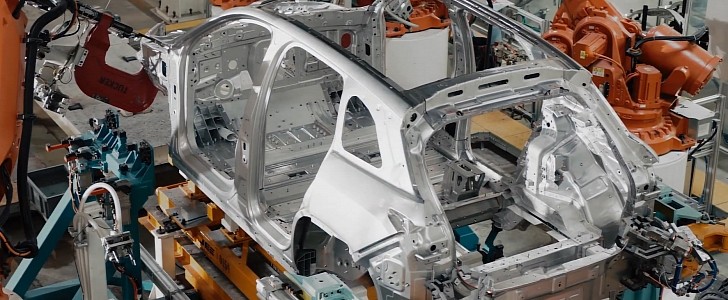When Tesla announced it would use mega castings to replace multiple stamped parts welded together once and for all, the automotive industry decided to watch. If the American automaker could do that, other companies would follow suit. Volkswagen and Mercedes-Benz already said they will, but NIO is the first Chinese manufacturer to announce the same.
These giant cast parts were just possible because of methods to avoid heat treatments. These processes ensured castings would not deform or break after they were taken out of their molds. When you can cast anything and put it to work immediately after production, you save time and money.
Heat treatment-free castings were probably used before in other industries. When they proved they were feasible elsewhere, Tesla was the first company to apply that to the automotive world. Curiously, Elon Musk recently said that manufacturing would make Tesla stand out from the competition. If it does, it will be for a short time, as NIO revealed.
As CNEVPost reported, the Chinese manufacturer spent more than one year and made thousands of tests to make sure that the process would provide parts that would be up to the task. As structural components, any failure with these huge cast parts would be catastrophic.
That seems to place NIO ahead of its German competitors. Volkswagen said Project Trinity would use cast parts but has not introduced any vehicle with the technology so far. Daimler also stated that the Mercedes-Benz EQXX would study large castings. However, the company did not even present the concept so far.
Considering we’ll only see a Trinity car by 2026, NIO may deliver its vehicle before the German carmakers. At least if it introduces its new-generation platform in the new models, it is expected to present at NIO Day 2021, on December 18. Some of them may hit the market in 2022. NIO’s oldest vehicle in production, the ES8, was presented in 2018. If it follows a lifecycle of six years (the industry’s average), it will only get its second generation by 2024.
The Chinese company expects to start using these massive castings with its next-generation platform, another one of the news we may see emerge from NIO Day 2021. Current NIO vehicles already use aluminum in their bodies, but only with stamped parts.
Heat treatment-free castings were probably used before in other industries. When they proved they were feasible elsewhere, Tesla was the first company to apply that to the automotive world. Curiously, Elon Musk recently said that manufacturing would make Tesla stand out from the competition. If it does, it will be for a short time, as NIO revealed.
As CNEVPost reported, the Chinese manufacturer spent more than one year and made thousands of tests to make sure that the process would provide parts that would be up to the task. As structural components, any failure with these huge cast parts would be catastrophic.
That seems to place NIO ahead of its German competitors. Volkswagen said Project Trinity would use cast parts but has not introduced any vehicle with the technology so far. Daimler also stated that the Mercedes-Benz EQXX would study large castings. However, the company did not even present the concept so far.
Considering we’ll only see a Trinity car by 2026, NIO may deliver its vehicle before the German carmakers. At least if it introduces its new-generation platform in the new models, it is expected to present at NIO Day 2021, on December 18. Some of them may hit the market in 2022. NIO’s oldest vehicle in production, the ES8, was presented in 2018. If it follows a lifecycle of six years (the industry’s average), it will only get its second generation by 2024.
The Chinese company expects to start using these massive castings with its next-generation platform, another one of the news we may see emerge from NIO Day 2021. Current NIO vehicles already use aluminum in their bodies, but only with stamped parts.






